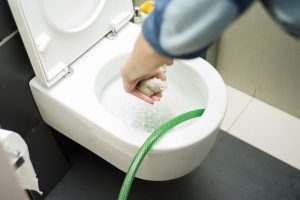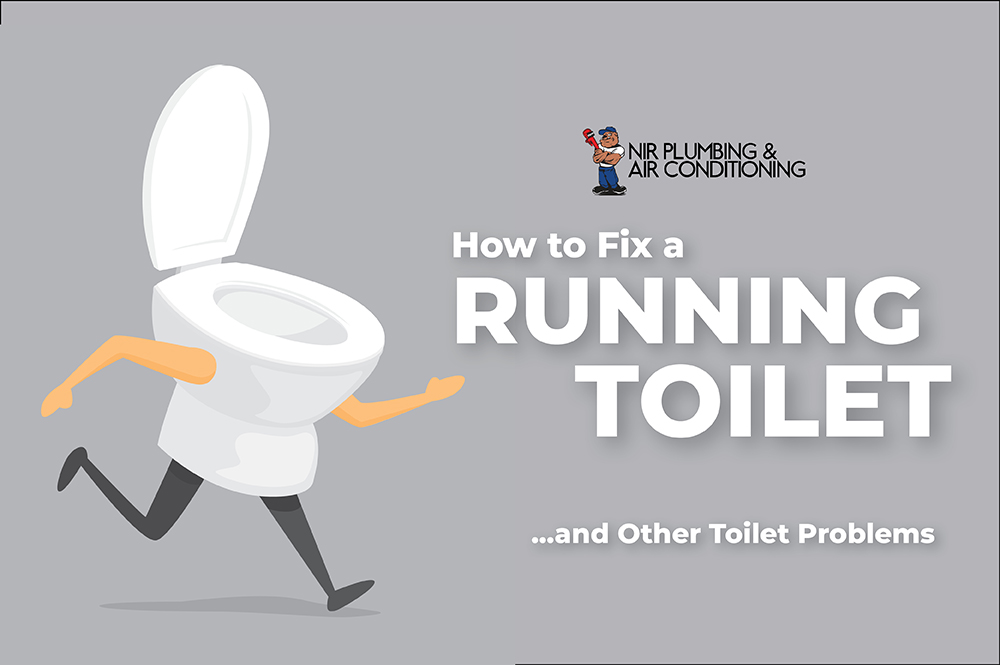[vc_row][vc_column width=”1/1″][vc_column_text] It’s 7 am, the sun is peeking over Riverside, birds are singing, and all is calm with the world. But inside your home, this weekday morning is nothing short of mayhem. As you gather your things, your spouse is flipping pancakes, one kid looks for an incessantly lost left shoe, and the other chases after your family’s new puppy. But, despite this routine madness, the morning seems to be going as anticipated. That is until someone shouts from across the hallway with a bout of bad news– the kind you dread to hear just before a day of work. That’s right. You’ve got a Code Brown. The toilet is running again. And all is put on pause as you’re forced to attend to this nuisance.[/vc_column_text][vc_column_text]
It’s 7 am, the sun is peeking over Riverside, birds are singing, and all is calm with the world. But inside your home, this weekday morning is nothing short of mayhem. As you gather your things, your spouse is flipping pancakes, one kid looks for an incessantly lost left shoe, and the other chases after your family’s new puppy. But, despite this routine madness, the morning seems to be going as anticipated. That is until someone shouts from across the hallway with a bout of bad news– the kind you dread to hear just before a day of work. That’s right. You’ve got a Code Brown. The toilet is running again. And all is put on pause as you’re forced to attend to this nuisance.[/vc_column_text][vc_column_text]
We’ve all been there. It’s a part of homeownership, after all! But in these moments, we at NIR Plumbing have a solution! In this article, we’ll discuss how you can address your home’s most foreboding toilet problems– when they are clogged and when they won’t stop running. Let us address the toilet issues of your life so you can focus on more important things, like getting out the door with all family members wearing both of their shoes.[/vc_column_text][vc_column_text]
We’ll start with how to fix a running toilet…
[/vc_column_text][vc_column_text]A running toilet is one of the most common plumbing issues a homeowner is likely to face. And what is usually their greatest concern is the inevitably large water bill that comes with this malfunction. That’s because a running toilet will cause water to go into the tank continuously but will never get prompted to stop. This perpetual cycle of filling and draining water is not only frustrating but is costly as well, often resulting in a $100/month water bill! So, without further ado, here are some items to consider if you want to fix a running toilet.[/vc_column_text][vc_column_text]First, we encourage you to gain an understanding of how your toilet works as your preliminary step in the diagnosis process. Flush it a few times with the lid off and watch how its different mechanisms work. With a glance at your refilling toilet tank, check to see if you notice any broken or clogged parts or any other issues.[/vc_column_text][vc_column_text]
Flapper Valve
[/vc_column_text][vc_column_text]The first place you will want to check is the flapper valve. This is the rubber piece at the bottom of your tank that fully covers the drain. You will want to flush your toilet and make sure that your flapper valve fully covers and closes. And if it doesn’t, you can conclude that this is your problem. Sometimes this is an easy fix of just jiggling the handle to make it close. In other instances, though, the rubber may be cracked and requires replacement. However, these pieces are easy to take off to be replaced with a new one.[/vc_column_text][vc_column_text]
Check the Chain
[/vc_column_text][vc_column_text]If you’ve ruled out the flapper valve as your problem, be sure to check the chain that is attached to the handle. Sometimes the chain is too long and can get caught under the flapper valve. This obviously will be a problem. But sometimes the chain can be too short. This also causes a problem because the flapper valve is unable to close, and your tank has no opportunity to refill and stop running. You may need to either lengthen or shorten the chain so that the flap can close easily but is not obstructed by the chain.[/vc_column_text][vc_column_text]
Cracked Float or tube
[/vc_column_text][vc_column_text]When you open up your toilet tank, you will see a ball resting on the top of the water. This is the device used to show when your toilet is full and no longer needs water. Sometimes this ball can become cracked, and water can seep into it. In this case, it no longer can float on the water and mark that it is full, so your tank continues to keep refilling. You may need to replace the ball so that it can sit on top of the water.[/vc_column_text][vc_column_text]
Next, let’s look at how to fix a clogged toilet…
[/vc_column_text][vc_column_text]
[/vc_column_text][vc_column_text]
What you’ll need:
[/vc_column_text][vc_column_text]
- A plunger with an extension flange. This allows the plunger to get a better seal and have a greater oomph behind each plunge.
- Rubber gloves
- Towels or rags
- Bucket and a big cup
[/vc_column_text][vc_column_text]
Step 1. Prep your area.
[/vc_column_text][vc_column_text]
[/vc_column_text][vc_column_text]
Step 2. Use the plunger
[/vc_column_text][vc_column_text]This may seem like a no brainer, but there is a right way and wrong way to do this. Before you stick your plunger in, make sure that no water will overflow with the use of a plunger. If needed, use a large cup to scoop water out into the bucket. Then, insert the flange plunger end into the toilet’s drain outlet, making sure that the outer bell of the plunger has a seal over the entire drain hole. Your first plunge should be gentle. Once you have gently pushed all the air from the plunger into the hole, you can vigorously plunge while maintaining the seal. If you do not see any progress, make sure you are patient. Some clogs do take quite a bit of plunging to break loose. Make sure enough water is in the bowl so that the plunger stays covered. Most of the time, this will fix your clogged toilet issues. If not, continue to step 3.[/vc_column_text][vc_column_text]
Step 3. Reach for a plumbing snake.
[/vc_column_text][vc_column_text]We have found that most people don’t keep plumbing snakes on hand. However, if you have one, check out this handy how-to video on using a plumbing snake.[/vc_column_text][vc_column_text]
Finally, How to fix a loose toilet handle…
[/vc_column_text][vc_column_text]Does your toilet handle feel loose? Does it wiggle or feel like there is too much slack when you try to use it? While this malfunction is undoubtedly frustrating, it might also affect the way your toilet operates. So, it is helpful for the longevity and usefulness of your toilet to fix this minor issue. Let’s look at two ways you can address it by either tightening or replacing the handle.[/vc_column_text][vc_column_text]
To tighten the handle, follow these steps:
[/vc_column_text][vc_column_text]
- Make sure that the toilet seat cover is closed and remove the toilet tank cover. Do so with two sides as this piece is likely quite heavy. Set the cover aside in a secure place, so it is not at risk of falling or getting cracked.
- Turn off the water valve for your toilet and hold down the lever to empty your tank. Doing this will allow you to tighten the handle from inside the tank. Wondering where this shut off valve is located? Check the base of your toilet near the back.
- Look in the tank for the metal nut that is directly adjacent to the handle. This nut is typically the cause of your loose handle.
- With an adjustable wrench, turn the nut counterclockwise until it is sufficiently tight. However, be careful not to make this too tight as it could crack the porcelain, leaving you with an even bigger problem!
- Test the newly tightened lever by pressing down on it. You’ll know if it feels and sounds better instantly. However, if you notice that it is still having an issue, you may need to replace it.
- Otherwise, turn on the water supply once more, allow the tank to refill, and you’re all set!
[/vc_column_text][vc_column_text]
To replace the handle, follow these steps:
[/vc_column_text][vc_column_text]
- First, it is helpful to know what hardware you’ll need based on the brand, model, and make of your toilet. However, universal handles, sold by most hardware stores, will work just fine as well.
- Follow steps one and two of the last set of directions for instructions on how to drain the toilet tank. This will allow you to work from inside the tank.
- Once the tank is emptied, look inside for the chain clip attached to the lever. This extends from the handle to the flapper. Undo this clasp to detach the toilet handle.
- From here, you’ll remove the mounting nut, which is the first nut you would have tightened in our first set of instructions. But here, you will loosen it instead. And with a pair of pliers, you can remove it altogether.
- When the nut and chain are removed, you can pull out the handle and throw it away.
- Now you’re ready for the new handle! Remove it from its packaging and unscrew the mounting nut.
- Put the new lever into the tank in the same way that you removed the old one. If the handle is flush with the side of the tank, you’ll know it’s been placed correctly.
- Secure the new handle with the mounting screw that came with it.
- You’ll need to reattach the chain to one of the holes on the new lever. There are usually a few to choose from, so you’ll be able to try a few different lengths until you find one that works well. Keep in mind that you’ll want about an inch of slack in the chain, so it flushes properly.
- Now, you’re ready to turn the water back on and test out your new lever! The toilet should easily flush without any hindrance. And there you have it, finito!
[/vc_column_text][vc_column_text]
[/vc_column_text][/vc_column][/vc_row]


